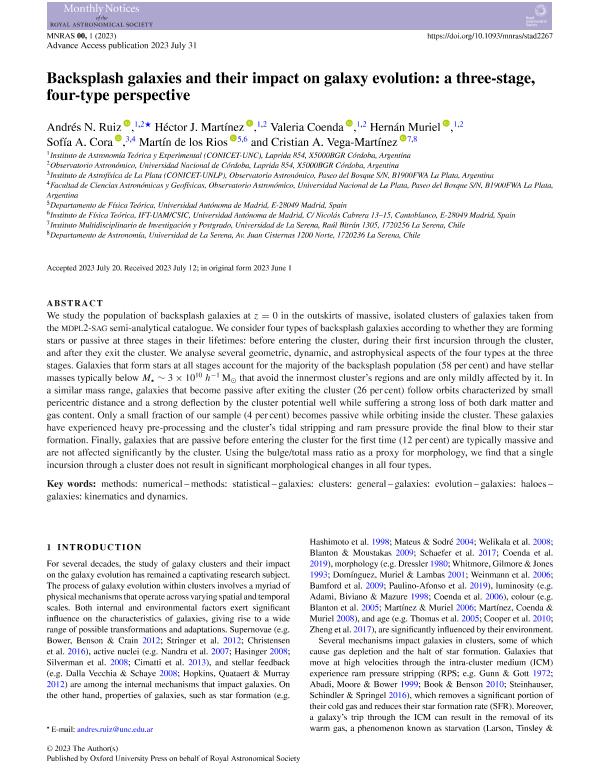Mostrar el registro sencillo del ítem
dc.contributor.author
Ruiz, Andrés Nicolás

dc.contributor.author
Martínez, Hector Julián
dc.contributor.author
Coenda, Valeria

dc.contributor.author
Muriel, Hernan

dc.contributor.author
Cora, Sofia Alejandra

dc.contributor.author
de Los Rios, Martín Emilio

dc.contributor.author
Vega Martínez, Cristian Antonio

dc.date.available
2024-04-12T14:44:22Z
dc.date.issued
2023-08
dc.identifier.citation
Ruiz, Andrés Nicolás; Martínez, Hector Julián; Coenda, Valeria; Muriel, Hernan; Cora, Sofia Alejandra; et al.; Backsplash galaxies and their impact on galaxy evolution: a three-stage, four-type perspective; Wiley Blackwell Publishing, Inc; Monthly Notices of the Royal Astronomical Society; 525; 2; 8-2023; 3048-3060
dc.identifier.issn
0035-8711
dc.identifier.uri
http://hdl.handle.net/11336/232895
dc.description.abstract
We study the population of backsplash galaxies at z=0 in the outskirts of massive, isolated clusters of galaxies taken from the MDPL2-SAG semi-analytic catalogue. We consider four types of backsplash galaxies according to whether they are forming stars or passive at three stagesin their lifetimes: before entering the cluster, during their first incursion through the cluster, and after they exit the cluster. We analyse several geometric, dynamic, and astrophysical aspects of the four types at the three stages. Galaxies that form stars at all stages account for the majority of the backsplash population (58%) and have stellar masses typically below Mstar ∼ 3×10¹⁰ Msun/h that avoid the innermost cluster´s regions and are only mildly affected by it. In a similar mass range, galaxies that become passive after exiting the cluster (26%) follow orbits characterised by small pericentric distance and a strong deflection by the cluster potential well while suffering a strong loss of both dark matter and gas content. Only a small fraction of our sample (4%) become passive while orbiting inside the cluster. These galaxies have experienced heavy pre-processing and the cluster´s tidal stripping and ram pressure provide the final blow to their star formation. Finally, galaxies that are passive before entering the cluster for the first time (12%) are typically massive and are not affected significantly by the cluster. Using the bulge/total mass ratio as a proxy for morphology, we find that a single incursion through a cluster do not result in significant morphological changes in all four types.
dc.format
application/pdf
dc.language.iso
eng
dc.publisher
Wiley Blackwell Publishing, Inc

dc.rights
info:eu-repo/semantics/openAccess
dc.rights.uri
https://creativecommons.org/licenses/by-nc-sa/2.5/ar/
dc.subject
GALAXIES: CLUSTERS: GENERAL
dc.subject
GALAXIES: HALOES
dc.subject
GALAXIES: KINEMATICS AND DYNAMICS
dc.subject
GALAXIES: EVOLUTION
dc.subject
METHODS: NUMERICAL
dc.subject
METHODS: STATISTICAL
dc.subject.classification
Astronomía

dc.subject.classification
Ciencias Físicas

dc.subject.classification
CIENCIAS NATURALES Y EXACTAS

dc.title
Backsplash galaxies and their impact on galaxy evolution: a three-stage, four-type perspective
dc.type
info:eu-repo/semantics/article
dc.type
info:ar-repo/semantics/artículo
dc.type
info:eu-repo/semantics/publishedVersion
dc.date.updated
2024-02-22T13:39:31Z
dc.journal.volume
525
dc.journal.number
2
dc.journal.pagination
3048-3060
dc.journal.pais
Reino Unido

dc.description.fil
Fil: Ruiz, Andrés Nicolás. Universidad Nacional de Córdoba. Observatorio Astronómico de Córdoba; Argentina. Consejo Nacional de Investigaciones Científicas y Técnicas. Centro Científico Tecnológico Conicet - Córdoba. Instituto de Astronomía Teórica y Experimental. Universidad Nacional de Córdoba. Observatorio Astronómico de Córdoba. Instituto de Astronomía Teórica y Experimental; Argentina
dc.description.fil
Fil: Martínez, Hector Julián. Universidad Nacional de Córdoba. Observatorio Astronómico de Córdoba; Argentina. Consejo Nacional de Investigaciones Científicas y Técnicas. Centro Científico Tecnológico Conicet - Córdoba. Instituto de Astronomía Teórica y Experimental. Universidad Nacional de Córdoba. Observatorio Astronómico de Córdoba. Instituto de Astronomía Teórica y Experimental; Argentina
dc.description.fil
Fil: Coenda, Valeria. Universidad Nacional de Córdoba. Observatorio Astronómico de Córdoba; Argentina. Consejo Nacional de Investigaciones Científicas y Técnicas. Centro Científico Tecnológico Conicet - Córdoba. Instituto de Astronomía Teórica y Experimental. Universidad Nacional de Córdoba. Observatorio Astronómico de Córdoba. Instituto de Astronomía Teórica y Experimental; Argentina
dc.description.fil
Fil: Muriel, Hernan. Consejo Nacional de Investigaciones Científicas y Técnicas. Centro Científico Tecnológico Conicet - Córdoba. Instituto de Astronomía Teórica y Experimental. Universidad Nacional de Córdoba. Observatorio Astronómico de Córdoba. Instituto de Astronomía Teórica y Experimental; Argentina. Universidad Nacional de Córdoba. Observatorio Astronómico de Córdoba; Argentina
dc.description.fil
Fil: Cora, Sofia Alejandra. Consejo Nacional de Investigaciones Científicas y Técnicas. Centro Científico Tecnológico Conicet - La Plata. Instituto de Astrofísica La Plata. Universidad Nacional de La Plata. Facultad de Ciencias Astronómicas y Geofísicas. Instituto de Astrofísica La Plata; Argentina
dc.description.fil
Fil: de Los Rios, Martín Emilio. Universidad Autónoma de Madrid; España
dc.description.fil
Fil: Vega Martínez, Cristian Antonio. Universidad de la Serena; Chile
dc.journal.title
Monthly Notices of the Royal Astronomical Society

dc.relation.alternativeid
info:eu-repo/semantics/altIdentifier/doi/https://doi.org/10.1093/mnras/stad2267
dc.relation.alternativeid
info:eu-repo/semantics/altIdentifier/url/https://academic.oup.com/mnras/article/525/2/3048/7234341
Archivos asociados
